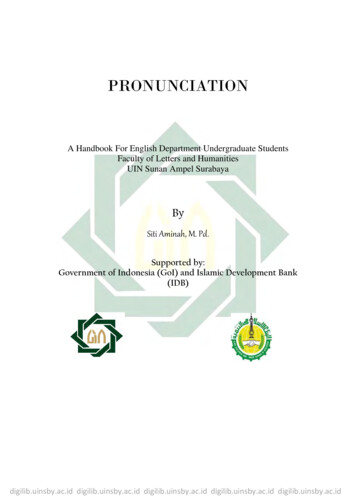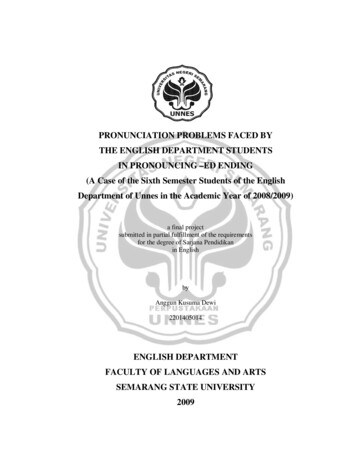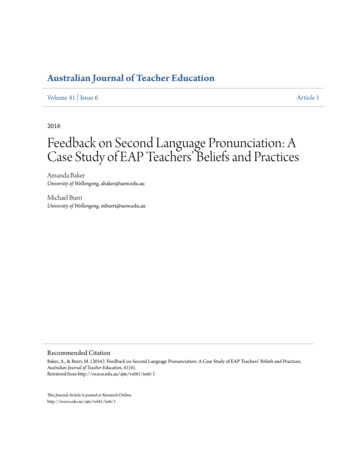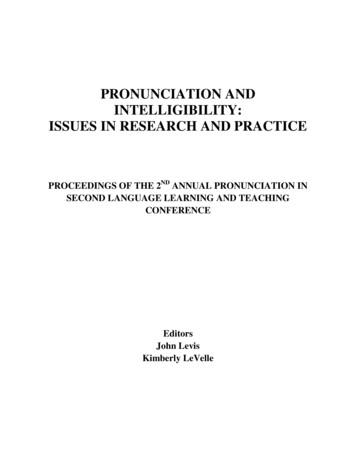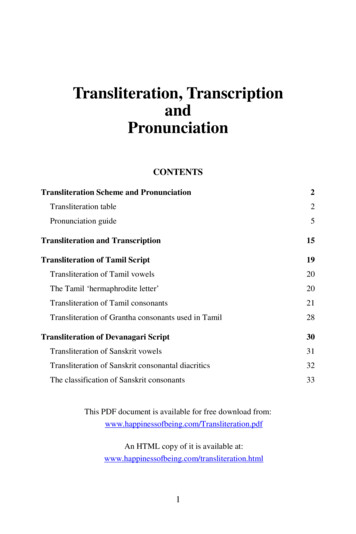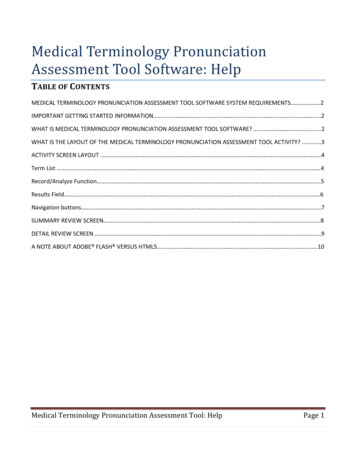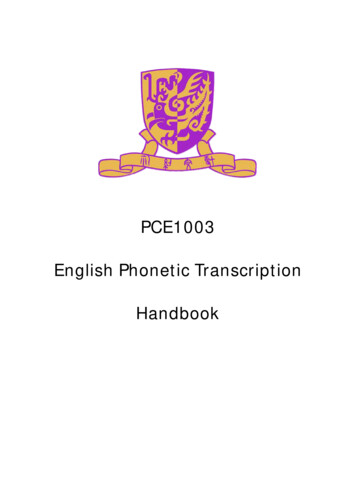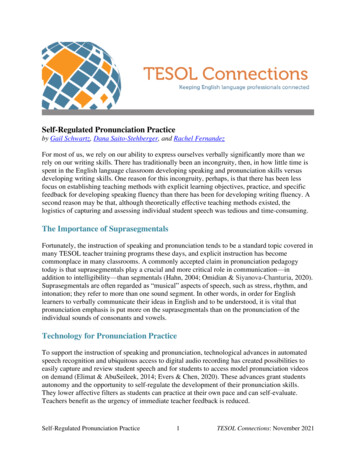
Transcription
Self-Regulated Pronunciation Practiceby Gail Schwartz, Dana Saito-Stehberger, and Rachel FernandezFor most of us, we rely on our ability to express ourselves verbally significantly more than werely on our writing skills. There has traditionally been an incongruity, then, in how little time isspent in the English language classroom developing speaking and pronunciation skills versusdeveloping writing skills. One reason for this incongruity, perhaps, is that there has been lessfocus on establishing teaching methods with explicit learning objectives, practice, and specificfeedback for developing speaking fluency than there has been for developing writing fluency. Asecond reason may be that, although theoretically effective teaching methods existed, thelogistics of capturing and assessing individual student speech was tedious and time-consuming.The Importance of SuprasegmentalsFortunately, the instruction of speaking and pronunciation tends to be a standard topic covered inmany TESOL teacher training programs these days, and explicit instruction has becomecommonplace in many classrooms. A commonly accepted claim in pronunciation pedagogytoday is that suprasegmentals play a crucial and more critical role in communication—inaddition to intelligibility—than segmentals (Hahn, 2004; Omidian & Siyanova‐Chanturia, 2020).Suprasegmentals are often regarded as “musical” aspects of speech, such as stress, rhythm, andintonation; they refer to more than one sound segment. In other words, in order for Englishlearners to verbally communicate their ideas in English and to be understood, it is vital thatpronunciation emphasis is put more on the suprasegmentals than on the pronunciation of theindividual sounds of consonants and vowels.Technology for Pronunciation PracticeTo support the instruction of speaking and pronunciation, technological advances in automatedspeech recognition and ubiquitous access to digital audio recording has created possibilities toeasily capture and review student speech and for students to access model pronunciation videoson demand (Elimat & AbuSeileek, 2014; Evers & Chen, 2020). These advances grant studentsautonomy and the opportunity to self-regulate the development of their pronunciation skills.They lower affective filters as students can practice at their own pace and can self-evaluate.Teachers benefit as the urgency of immediate teacher feedback is reduced.Self-Regulated Pronunciation Practice1TESOL Connections: November 2021
In our classrooms, both virtual and face-to-face, we have had success with the following threepronunciation learning activities. The learning activities have engaged students, andimprovement in pronunciation has been evident. The two types of free technology used in theselearning activities are Google Voice Typing and FlipGrid. These learning activities are easilyadaptable to any set of vocabulary.Google Voice TypingGoogle Voice Typing is a free online transcription tool available in Google Docs and GoogleSlides. Students use the tool to determine how intelligible their speech is. They speak into themicrophone and see the tool type out what it has “understood.” Google Voice Typing has beendocumented as having 95% accuracy (McCrocklin & Edalatishams, 2020), which is similar tohow well a native speaker might understand the nonnative speaker. See Appendix A forinstructions on how to enable Google Voice Type on your desktop.FlipgridFlipgrid is a free video discussion tool created by Microsoft that can be accessed using aMicrosoft or Google account. In these assignments, teachers use Flipgrid to post modelpronunciation of the learning tasks, which is easily accessible with a simple link. Students recordand rerecord their learning tasks until they are satisfied and then post to a different Flipgrid page.Sign up for a teacher’s Flipgrid account here.Pronunciation ActivitiesLearning Activity 1: Pronunciation of Vocabulary in ContextOverviewThis task involves students listening several times to a teacher-created video sample, speakingthe sentences themselves, and reflecting.Learning Objectives Improve learner’s comprehensibility using new vocabulary. Raise awareness of an individual's pronunciation challenges. Increase familiarity with vocabulary, collocations, and use in context. Practice pausing, emphasizing keywords, and stressing the appropriate syllable forimproved comprehensibility. Promote autonomy in working on pronunciation.Steps1. Create and post a video sample of the pronunciation of 10 sentences with the chaptervocabulary used in common contexts or collocations. Video is preferred over audio as itallows students to see the movements of the mouth.2. Create a Google document using a three-column table: (1) your sentence (with words andsyllables that should be stressed and with places that require a pause), (2) students’Self-Regulated Pronunciation Practice2TESOL Connections: November 2021
3.4.5.6.pronunciation, and (3) student comments on any issues with pronunciation of particularwords/phrases. See Appendix B for student handout.Provide clear instructions and demonstrate how to use Google Voice Typing.Students watch the video/teacher model. The first time, they watch and listen; the secondtime, they listen with a focus on syllable stress, keyword stress, pausing, and vowelpronunciation.Students read the sentences aloud into Google Voice Typing. Encourage them to readeach sentence several times to achieve accuracy but not more than three times so they canavoid too much frustration.Students reflect in an online discussion, sharing what they learned.Feedback/Assessment Comment on a couple of students’ issues. Review common difficulties and indicate how those issues may be addressed. (SeeRachel’s English for more exercises and videos on syllable stress, keyword stress, and soon.) Give full marks to any student who did the assignment, regardless of accuracy.Notes You could include several sentences for more context, especially for advanced levelstudents. For lower levels, simple sentences should be usedLearning Activity 2: Pronunciation Differences Within Word FamiliesOverviewThis task involves students reviewing vocabulary, listening to examples of the vocabulary readaloud, and posting a video that emulates your pronunciation.Learning Objectives Raise awareness of the pronunciation differences within word families. Use the vocabulary in a sentence and raise awareness of grammar and collocations (wordfriends). Analyze the value of using a teacher model and its value in helping students hear thedifferences in pronunciation within a word family.Steps1. Create Google slides reviewing vocabulary definition, word forms, and use in a sentence(see Appendix C) and a model video in which you read the vocabulary word, the sentencein context, and each of the high-frequency word forms. (See example model video here.)Video is preferred over audio as it allows students to see the movements of themouth. The focus is on syllable stress and pronunciation of vowels (as they changedepending on the stressed syllable) as well as on the rhythm in the sentence that uses thevocabulary.2. Provide clear instructions and demonstrate how to use Flipgrid.Self-Regulated Pronunciation Practice3TESOL Connections: November 2021
3. Have students review the Google slides in class (and on their own) and then listen to themodel/video.4. Students post a video on Flipgrid of themselves emulating your pronunciation. (Seeexample student videos here and here.)5. Encourage students to practice before they post and/or feel free to post on Flipgrid anddelete until they are satisfied with their video.6. Have students reflect in an online discussion about what they learned from the task.Feedback/Assessment Provide comments on Flipgrid, which allows for video and/or written feedback. Feedback with encouragement along with a couple of suggestions works well. Make notes of patterns/issues for future lessons.Notes For lower levels, the focus could be on word families, appropriate to the level. On Flipgrid, you can include captions (recommended) on the instructor example video.The students can also check their own pronunciation using the closed captions that arecreated. However, the accuracy on Flipgrid is not as good as Google Voice Typing. It isnot recommended unless the students’ pronunciation is at a very high level.Learning Activity 3: Stress, Rhythm, and IntonationOverviewIn this task, students read a passage from their textbook that has been marked for stress andpauses, listen to a reading of the paragraph, and then post a video of themselves reading theparagraph.Learning Objectives Increase awareness of what keyword stress, pausing, and intonation sound like. Practice speaking with proficient rhythm with a heightened focus. Gain an understanding of how the rhythm of English helps convey meaning. Improve pronunciation by practice and self-evaluation (before recording). Reflect on the process and the importance of rhythm.Steps1. Teach the basics of keyword stress, pausing, and intonation, and why this is important(see Rachel’s English for videos on word stress and linking and thought groups).2. Create a handout with a paragraph from your textbook marked with bolded words(keywords) for stress (louder, longer) and pauses (//). Post a video of yourself reading theparagraph. (See an example here.) Video is preferred over audio as it allows students tosee the movements of the mouth.3. Provide clear instructions and demonstrate how to use Flipgrid.4. Provide students with the passage, read it to the class, and point out how the rhythm helpsconvey meaning.5. Have students view the posted video as many times as needed. Also ask them to noticeand emulate the intonation.Self-Regulated Pronunciation Practice4TESOL Connections: November 2021
6. Have students post their own video; encourage them to practice several times beforeposting. (See example student videos here and here.)7. Students reflect on the process and their understanding of the value of stress, pausing, andintonation.Feedback/Assessment Provide comments on Flipgrid, which allows for video and/or written feedback. Feedback with encouragement along with just a couple of suggestions works well. Make notes of patterns/issues for future lessons.Notes Consider a subsequent lesson where students mark up the text themselves and post avideo. This is a high intermediate/advanced task.ConclusionBecause the research clearly indicates the importance of suprasegmentals for nonnative speakers’comprehensibility, and because automated speech recognition has improved dramatically, it isincumbent upon instructors to help our students take advantage of these tools and create moreactivities that foster student autonomy to work on stress, rhythm, and intonation as well asimprove pronunciation with segmentals.ReferencesElimat, A. K., & AbuSeileek, A. F. (2014). Automatic speech recognition technology as aneffective means for teaching pronunciation. JALT CALL Journal, 10(1), 21–47.Evers, K., & Chen, S. (2020). Effects of an automatic speech recognition system with peerfeedback on pronunciation instruction for adults. Computer Assisted Language Learning, 04Hahn, L. D. (2004). Primary stress and intelligibility: Research to motivate the teaching ofsuprasegmentals. TESOL Quarterly, 38(2), 201–223. https://doi.org/10.2307/3588378McCrocklin, S., & Edalatishams, I. (2020). Revisiting popular speech recognition software forESL speech. TESOL Quarterly, 54(4), 1086–1097. https://doi.org/10.1002/tesq.3006Omidian, T., & Siyanova‐Chanturia, A. (2020). Semantic prosody revisited: Implications forlanguage learning. TESOL Quarterly, 54(2), 512–524. https://doi.org/10.1002/tesq.557Gail Schwartz has taught academic and business English for nearly 20 years, subsequent to acareer in marketing. During her 15 years at the UC Irvine Division of Continuing Education, shealternated quarters between teaching all levels and skills in their Intensive English program andSelf-Regulated Pronunciation Practice5TESOL Connections: November 2021
teaching six courses in their Business English program. Ms. Schwartz now teaches adult ESLclasses at Irvine Valley College, where she won the 2020 Associate Professor of the Year award.Ms. Schwartz has an MS in TESOL and an MS in urban and regional studies.Dana Saito-Stehberger is a research specialist at UC Irvine Digital Learning Lab, where she ispart of the Elementary Computing for ALL team, creating curriculum and supporting teachers asthey teach computational thinking to English language learners. She has experience teachingEnglish language learners for the past 25 years. Her interests include instructional design,integrating technology into teaching and learning, culturally relevant pedagogy, and the impactof collaboration on learning. She has an EdD in TESOL.Rachel Fernandez has an MA in Spanish and a certificate in ESL. She has taught Spanish andEnglish at high school, community college, and university levels. She has been an instructor atUC Irvine Division of Continuing Education since 2004, teaching a highly diverse studentpopulation in the English for Internationals programs and training teachers in the TEFLCertificate programs.Self-Regulated Pronunciation Practice6TESOL Connections: November 2021
How to Enable Voice Typing in Google Docs (desktop version)1Step 1: Turn on Your MicrophoneTo use voice typing or voice commands, your computer microphone needs tobe on and working.Step 2: Start voice typing in a document1.2.3.4.5.1Check that your microphone works.Open a document in Google Docs with a Chrome browser.Click Tools Voice typing. A microphone box appears.When you’re ready to speak, click the microphone.Speak clearly, at a normal volume and pace (see below for moreinformation on using punctuation).From Kasey Bell’s y-voice-typing-google-docs/Schwartz et al.Appendix ATESOL Connections: November 2021
6. When you’re done, click the microphone again.NOTE: The user must be connected to the internet through the Google Chrome Browseron Windows, MacOS or Chromebook devices or on Google Android devices.Schwartz et al.Appendix ATESOL Connections: November 2021
Learning Activity 1: Pronunciation Practice: 10 sentences(Unit 3, Future Advanced)Before you do the activity, make sure you know the words.The list is on Quizlet and the example video is on Canvas.Record yourself reading each sentence in the table.Directions:1. Click on “Tools” at the top of a Google Doc Page.2. Click on “Voice Typing.” A microphone icon will appear.3. Click your cursor in the column next to the sentence you will read. The VoiceTool will write what you say there.4. Click on the microphone icon to record and read the sentence.When you read: Speak loudly.Bolded syllables are stressed. Say them louder and longer.The symbol // shows the end of a thought group. Make a brief pause.Keywords are in green. Emphasize these words.Remember: This can help you see the accuracy of your pronunciation and identify problemareas. The Voice Tool is about 95% accurate. You are graded on the completion of this assignment, not the accuracy of yourpronunciation. If you have tried three times, move on to the next sentence even if it isn’t perfect. Put any comments you have in the third column.Schwartz et al.Appendix BTESOL Connections: November 2021
Sentence Withvocabulary Word/Phrase Bold—stressedsyllable or word //—pause Bolded words ingreen font—keywords; should beemphasizedYour RecordingsYour CommentsClick your cursor in thiscolumn and the Voice Toolwill write what you sayhere.What was difficult?What do you havequestions about?Don’t get frustrated. If youtry three times and don’tget it right, you can moveon.Trial and error is avaluable way to learn//many different skills.You don’t need toeliminate your accent //when you speak English. //You just need to becomprehensible.The stock market canfluctuate a lot during timesof economic uncertainty.Sometimes it is hard todetect when our childrendon’t understandsomething.It can be very nervewracking to make apresentation in front of thewhole class.Science tells us that it paysoff to exercise. // We canfeel better physically andemotionally.Student debt is a bigproblem in the UnitedStates.Schwartz et al.Appendix BTESOL Connections: November 2021
Unit 9 Vocabulary (Future Advanced)Word FamiliesSentence ExamplesCollocations (Word friends)
Objectives:1. to raise awareness of the pronunciationdifferences within word families2. to use the vocabulary in a sentence and raiseawareness of grammar and collocations (wordfriends)3. to analyze the value of using a teacher model
General Directions1. Begin by looking at each slide to become familiar with the word family.Note the syllable stress and how it changes with different parts ofspeech.2. Listen to the instructor’s Flipgrid video. You will hear the sentence,and each word form pronounced.3. You will then record yourself on Flipgrid, trying to get yourpronunciation close to the instructor’s model. You may want to usethe AI-generated captions to see if you are getting close. (This is notperfect, but it should give you an idea. If the caption is completely off,you may want to try again.)4. You will have an opportunity to share your reflections about thisassignment.
Specific steps for the task1. Print out the slides so you can easily read or havethem available on another device.2. Say the vocabulary word in ORANGE that is in thesentence3. Read the sentence.4. Say: the part of speech (NOUN, VERB, ADJECTIVE,ADVERB) Example: NOUN: Eligibility5. Speak LOUDLY
1. ELIGIBLE: I wonder if he is eligible for the trackteam.(DEF: qualified to participate)Noune li gi BI li tyVerbAdjectiveAdverbE li gi bleE li gi bly
2. INSTALLED: We installed anti-viral software.(DEF: to put in a piece of equipment and make it readyfor use)NounVerbin sta LAtionin STALLAdjectiveAdverb
3. INITIATIVE: I took the initiative to call the clientabout their problem.( DEF: a plan or program to solve a problem)NounVerbAdjectivei NI tia tiveI NI ti atein NI ti at edAdverb
4. INTERVENTION: The family planned an interventionso he would get help for his drug addiction.( DEF: interference to change an outcome)NounVerbAdjectivein ter VENtionin ter VENEIn ter VEN ingAdverb
5. MODIFY: We need to modify the dosage since she isnot getting better.( DEF: to make a small change)NounVerbAdjectivemod di fi CAtionMO di fymo di FI a bleAdverb
6. INDICATE: Her symptoms indicate that there is anunderlying medical condition.( DEF: to demonstrate/suggest; to point out)NounVerbAdjectiveAdverbin di CA tionin di catein DI ca tiveIn DI cat tive ly
Learning Activity 3: Pronunciation Practice: Stress, Rhythm, and Intonation(Unit 2, p.174 Future Advanced)Before you record your video:Listen and read along to the example video on Flipgrid.Note which words are stressed/emphasized and when to pause (//) as indicated.How Should We Handle the Obesity Epidemic?In 2010,// Michelle Obama founded the Let’s Move! Campaign to reduce childhoodobesity. //She believed schools were the best place// to tackle obesity.// Nearly 50million children eat at least one meal //at school every day.// Let’s Move!encouraged schools to serve// more whole grains,// fruits, and vegetables.// Itworked and proved that schools could change children’s eating habits. Content words are in BOLD (noun, verb, adjective, adverb )Function words are unstressed (conjunctions, pronouns, articles, etc.)Focus words are BOLD and underlined (words emphasized most in a phrase)Pauses are marked with // (after a thought group/phrase)Directions1. Go to the Flipgrid link to post your recording.2. Read the above paragraph following the instructor’s model and trying to use thesame rhythm (stress, pausing, and intonation).3. Optional: You can record the second half of the paragraph (no teacher model)using your new awareness.Salad bars were added in thousands of schools. Soda machines and desserttrays were taken away. Let’sMove! also urged schools to get students moving. Aleast an hour of physical education was added to the daily schedule at manyschools.4. Then, write a reflection on the Canvas Discussion about what you learned fromthis exercise.Schwartz et al.Appendix DTESOL Connections: November 2021
Note about keywords and focus words: Content words are stressed, and focuswords are stressed even more. In addition, pay attention to pausing (after commas,paragraphs, and all thought groups). A thought group is a phrase with words thatshould be linked, if possible.To stress words, we say them louder, longer, and with a higher pitch. We often linkwords within a thought group but not between thought groups.Content words and focus words: STRESSED—louder, longer, higher pitch (nouns,verbs, adjectives, adverbs). These get a full beat (think of music).Function words: UNSTRESSED—softer, shorter, lower pitch (of, and, the, he)Here are some more videos about stress and thought groups:https://www.youtube.com/watch?v QPbNhsCkj7k&t 2s Word stress video Rachel’s Englishhttps://www.youtube.com/watch?v o-JtcSzL3Ic Linking and thought groups Rachel’s EnglishSchwartz et al.Appendix DTESOL Connections: November 2021
Self-Regulated Pronunciation Practice 1 TESOL Connections: November 2021 Self-Regulated Pronunciation Practice by Gail Schwartz, Dana Saito-Stehberger, and Rachel Fernandez For most of us, we rely on our ability to express ourselves verbally significantly more than we rely on our writing skills. There has traditionally been an incongruity, then .
